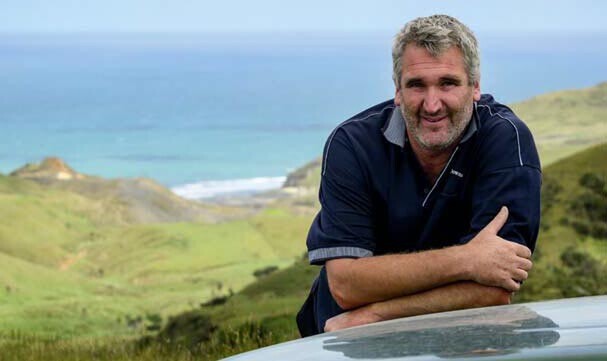NO RINGWRAITHS NOW – it’s all beef and sheep
Limestone Downs Farm is famous the world over for being a location in The Lord of the Rings trilogy. But Peter Jackson wasn’t the first to recognise its outstanding natural beauty – around the time that Tolkien was writing his epic novel, moves were already afoot to preserve the land in posterity. ANGELA KEMP reports.
Chances are if you’ve fl own south from Auckland Airport you’ll have had a bird’s eye view of Limestone Downs. It lies some 15kms south of Port Waikato in steep hill country, much of it served by a winding metal road.
This large-scale commercial farm is owned by the C. Alma Baker Trust which makes regular awards in support of research projects and postgraduate scholarships in agriculture. The Trust, which operates in New Zealand and the United Kingdom, draws most of its revenue from Limestone Downs station.
Although now a profitable beef, sheep and dairy operation and facilitator to important agricultural research, this hasn’t always been the case.
When the property was purchased by Charles Alma Baker in 1926 for £30,600, more than a third of the land was still in bush. The pasture had mostly been lost to the depredations of rabbits and had reverted to weeds.
Compare that to today’s farm and there is little to recognise bar the limestone outcrops which have been part of the landscape for thousands of years.
It is two years since Paul Mahoney became general manager of the station’s 3200 hectares, consisting of 1700 hectares in sheep and beef and about 520 hectares in dairy.
General manager - Paul Mahoney
“We are remote but we have fishing at our front door, hunting out the back door and a great team of guys here,” Paul says. “We have the estuary down below so the kids get to play in there and we go surf casting off the rocks. We’re just over 2kms from the beach and then we have about 5kms of beach which is popular with surfers.
“It’s hard on my wife Stacey who has to be in town three or four times a week for swimming, netball, basketball, softball … but I guess living out in the country you just have to make it work.”
The couple have three children – Bethany (12), Briar (10) and Holly (7) who attend Onewhero Area School.
The family has wasted no time becoming involved in the community. Last year students from Onewhero collected about 1000 bags of chook manure to raise funds for a ‘Spirit of Adventure’ experience. Soon they will invite another group of students to pick sweetcorn grown from donated seed to sell as a fundraiser.
“Stacey is putting forward an AIMES girls’ team for basketball and the more money they raise the less the parents have to pay.”
Paul and youngest daughter, Holly, are members of Port Waikato beach care group set up to protect dotterels that nest in the area.
Every three months the station hosts a student from the United Kingdom who is provided with accommodation in a self contained lodge on the farm. It also hosts regular visits from industry tour groups keen to learn about the research being carried out.
Earth science students from Massey University spend a two-three week field trip at the station and students from both Pukekohe High School and Dilworth School are regular visitors.
Every year in February the farm holds an open day which is popular with curious locals and those interested in the research trials.
“For the past three years we’ve been involved in a beef trial in partnership with Massey University and Beef and Lamb Genetics which could result in less bobby calves. We’re also doing a fly trial looking at the correlation of flies and fly strike,” Paul says.
Limestone Downs is also a popular trails venue and has hosted a rally for Pukekohe Race Club and is soon to welcome a BMW club for a tour around the farm on motorcycles. They’ll fi nish the day with lunch at nearby Nikau Caves.
Less popular are the (mainly) overseas visitors who drive out to see the outcrops used as a location for ‘Weathertop Hollows’ in the Lord of the Rings movie when Ringwraiths attack Frodo’s camp in the dell.
“We probably get them three or four times a week. Some try and get to it but most just want to say they’ve seen it. It can be quite dangerous as the road is windy and people just stop their cars in the middle.”
And, of course, at the end of the day this is a working station of large proportion – to have unsupervised guests is inappropriate for many reasons including safety.
WHO WAS CHARLES ALMA BAKER?
Charles Alma Baker was born in 1857 in Oamaru, New Zealand, where his parents, migrants from London, built the town’s fi rst hotel. Trained as a surveyor, Baker moved to Auckland where he married Florence, daughter of Sir Frederick Whitaker, a prominent businessman and former Premier of New Zealand.
Charles spent most of his life in Malaya, where he was a surveyor and owned tin and rubber plantation and where he quickly accumulated a modest fortune adding to his already considerable wealth.
By the early 20th century, he held the largest privately owned rubber plantations in the region and developed an interest in the preservation and enhancement of soil quality becoming a supporter of the early movement for biodynamic farming.
Overseas achievements aside, bringing world-renowned fisherman and author Zane Grey to New Zealand, improving the design of fishing reels and financing British aircraft in both world wars are among this remarkable man’s other notable deeds.
But perhaps the most enduring is the C Alma Baker Trust and Limestone Downs, a 3219 hectares dairy, sheep and beef property near Port Waikato. It’s this large-scale commercial farm which supports the work of the charitable trust, set up to fund agricultural research and development.
Charles’ link to Limestone Downs began in the 1920s, when he joined his nephew in a farming venture at Te Karaka station, near Port Waikato.
Later the adjacent property Limestone Downs was purchased and Charles invested profits from his interests in rubber into developing the farm.
After the Second World War, and Charles’ death in 1941, Limestone Downs languished until the arrival of a new manager, Don O’Connell in 1950 and a rubber boom in Malaya that contributed some of the capital needed to breathe new life into the farm.
The Trust was formed in 1981 and included the involvement of Massey University in the farm’s management. Its modus operandi was radically altered – rather than being a station run by extensive farming methods, Limestone Downs was to be farmed intensively. The emphasis was now on subdivision using electric fencing, smaller paddocks, smaller fl ocks and herds, rotational grazing and higher performing livestock.
To achieve this level of change, stock were assessed and culled on performance, new breeding programmes were established for sheep and cattle, and the farm was an early promoter of a bullbeef initiative using weaner calves from the dairy industry.
Vehicle access on the farm was improved, fertiliser needs assessed, and a new water reticulation scheme constructed.
Today the property is administered by an NZ-based committee, appointed by the English trustees of the C Alma Baker Estate.
The farm and trust’s strong links with Massey University remain, with the trust providing some funding for agricultural and horticultural research at the university. Every year four members of the UK Young Farmers Club come to work on the farm for three months each – when one leaves, another one arrives.
Originally Published in Rural Living Magazine, Feb 2019. Used with permission.



